They’re drilling in Topanga
April 27, 2012
Residents of Topanga Canyon enjoy some of the best nature has to offer. But because the area is susceptible to wildfires, they also prepare for the worst. Those preparations will kick into a much higher gear at this year’s “Ready, Set, Go” Topanga Evacuation Drill, which takes place Saturday, April 28.
For the first time, residents will be asked to leave the canyon completely, as they would in a “worst-case” fire emergency. During previous evacuation drills, participants stayed in the canyon and checked into Community Survival Areas. This exercise represents a revised strategy by government agencies and Topanga’s famously active community groups.
“We have been trying to get people to understand that when they are told to evacuate, the safest thing for them and their family is to leave the canyon,” said Pat MacNeil of the Topanga Coalition for Emergency Preparedness (T-CEP). “Refuge areas are a last-ditch option.”
While the canyon roads will not be closed, Los Angeles County Fire Department and other first responders are making the exercise as realistic as possible. There will be Red Cross evacuation centers, radio coverage from KNX 1070 and an Incident Command center at King Gillette Ranch. Alert LA County will send out mass communications every 15 minutes with traffic information and simulated fire locations. The “fire” itself will be phased in by Tactical Zones, which are based on known fire behavior during a wind-driven wildfire. Residents can check an online map to identify their zone.
The Los Angeles County Department of Animal Care & Control Equine Response Team is organizing a horse evacuation simulation for the event. Horse owners are encouraged to drive their trailers (without horses) to Pierce College in Woodland Hills.
The evacuation will also help first responders fine tune their procedures for the real thing, learning lessons that will apply locally and countywide.
“I think that what it does for the agencies is sharpen their skills and… awareness of the canyon,” said MacNeil. “You get them up on these winding roads and it can be a bit of a problem if they haven’t been there before.”
To encourage community participation, donated survival products and other gifts will be handed out to residents who check in at one of two evacuation centers—Taft High School or Palisades High School. There will also be drawings for prizes including a 4-person survival kit and tickets to the Will Geer Theatricum Botanicum.
For further information, residents should refer to the detailed packet they received in the mail. It spells out suggested day-to-day preparedness activities leading up to the actual 10 a.m. to 2 p.m. evacuation drill on Saturday, April 28.
Posted 4/27/12
Subway gets green light, and a detour
April 27, 2012
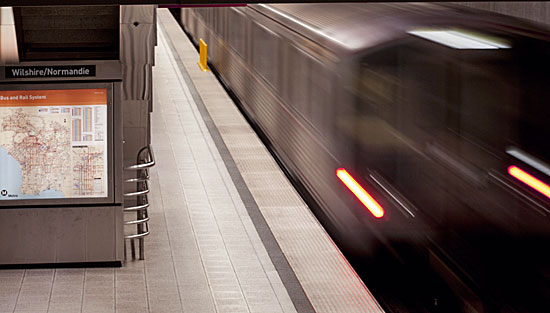
The first phase of the Westside Subway, approved this week, will run from Wilshire and Western to La Cienega.
The decades-old dream of building a subway to the Westside of Los Angeles reached a major milestone this week, with the Metro board’s certification of final environmental documents for the project.
The board also approved station locations for the subway’s 3.9-mile first phase, which will extend the Purple Line subway from Wilshire and Western, with stops at La Brea, Fairfax and La Cienega.
But, responding to recent actions taken by the city of Beverly Hills, the board stopped short of approving the entire 9-mile route ending at the Veterans Administration Medical Center in Westwood. Instead, Metro directors voted to postpone a decision on the subway’s final two segments until a hearing can be held to allow Beverly Hills officials to air their concerns about the proposed placement of a station on Constellation Boulevard in Century City, which would require tunneling under Beverly Hills High School.
Beverly Hills requested the hearing under a seldom-used provision of the state’s Public Utilities Code. After the hearing, to be held within the next 30 days, Metro could take up consideration of the final phases of the subway project.
A standing-room-only crowd packed the Metro board’s hearing room Thursday. Many extolled the subway—and the Constellation Boulevard station location—as a job-creating project and much-needed alternative to the traffic-clogged streets around Westside employment centers.
Hilary Norton, executive director of the group FAST (Fixing Angelenos Stuck in Traffic,) reminded the board that a healthy majority of county voters supported taxing themselves to build the subway and projects like it.
“I am here to say thank you for keeping your promise to the 67% of the county’s voters that came to vote for Measure R in support of the Westside Subway,” she said. “For all of us who are parents, who have children and are coming here from these areas outside the study area and need a subway, we ask for your support today.”
But a series of speakers from Beverly Hills said they are worried about the safety of tunneling under the high school property, and about the potential impact on future development plans on the campus. Many said they support placing the Century City station instead on Santa Monica Boulevard—a location that Metro’s scientific experts, including noted seismologist Lucy Jones, say is too dangerous because of active earthquake faults there.
Lisa Korbatov of the Beverly Hills Unified School District Board of Education, a vocal opponent of tunneling under the high school, urged the Metro directors Thursday to closely read reports by experts hired by Beverly Hills. She said it is still possible to “press the re-start button” and reach common ground.
“Let’s have dialogue, open, meaningful, comprehensive communication, and let’s all read the science,” she said.
Added Beverly Hills council member Barry Brucker: “We only ask that science, all the science available, determine the real safety risks and construction challenges, and guide all the important decisions of the Westside extension.”
But Supervisor Zev Yaroslavsky, a member of Metro’s board of directors, said that Beverly Hills’ scientific experts came to “largely the same conclusions that we did—cautioning that we need to be careful and we need to do it right. And we ought to be careful and we ought to do it right.”
“No member of this board of the MTA would want to build a tunnel under any building or under any home in any part of the county of Los Angeles that wasn’t safe,” he added. “But if it’s safe in one part of the county of Los Angeles, it’s safe in every part of the county of Los Angeles.”
Yaroslavsky said he also holds out hope that “problem-solvers” on both sides can get together and work things out, particularly when it comes to making sure that Metro’s plans don’t interfere with future development on the high school campus.
“There is room to talk,” he said, “and there is room to make this work for everyone concerned.”
The Metro board voted 11-1-1 to approve the environmental report and first phase of the subway, with Supervisor Michael D. Antonovich voting no and Supervisor Mark Ridley-Thomas abstaining. Phase one of the subway is expected to break ground next year and to be completed by 2020, although efforts are underway to accelerate that timetable.
Posted 4/26/12
A bright idea saves energy—and jobs
April 27, 2012
 How many light bulbs does it take to save taxpayers $1.8 million annually and change the course of a layoff?
How many light bulbs does it take to save taxpayers $1.8 million annually and change the course of a layoff?
The answer lies in an innovative new Los Angeles County program that will not only upgrade more than 25,000 lights in county buildings, but also preserve the jobs of nearly a dozen county employees while generating an ongoing source of money for energy efficiency.
The initiative—a revolving fund that will pay in perpetuity for energy retrofitting in county buildings—is the fruit of a $5 million state grant underwritten by federal stimulus money and accepted this month by the Board of Supervisors.
“We’ve been trying for years to set up something like this,” says Tom Tindall, director of the county’s Internal Services Department. He says that, while the county has undertaken hundreds of energy efficiency projects, most have been essentially one-offs, paid for with California Public Utilities Commission grants, departmental savings, specified grants or other one-time revenue sources.
“This will let us do energy projects essentially forever by setting up a fund that will replenish itself,” Tindall says.
For all its conservation, Los Angeles County remains one of California’s most prolific energy consumers.
“Put it this way: We’re Southern California Edison’s biggest customer,” says Howard Choy, general manager of ISD’s Office of Sustainability.
Choy says the county spends well over $150 million a year to power the multitude of office buildings, hospitals, jails and other facilities that make up its vast holdings. The bill for electricity at the Sheriff’s Department alone is about $20 million a year, he says.
Consequently, even a small improvement in efficiency can yield big savings, which is why Tindall, Choy and others were eager to create an ongoing pool of money for projects that would help lower the county’s utility bills.
Despite the county’s financial straits, the Chief Executive Office had planned to earmark $2.2 million in seed money for the idea out of the general fund for the next fiscal year. Then, this month, the California Energy Commission stepped up. The $5 million grant the county received from the commission is expected to result in more than $18 million in utility savings over the next decade.
Under the plan, county departments will be able to “borrow” from the fund to make their buildings more energy efficient, then channel the utility savings back into it until the project’s initial cost is “repaid.” Staff from internal services will perform the work with existing county employees. Most projects, Choy says, will pay for themselves in two to four years.
“After that, the department itself will get to see the savings every year going forward, plus have a better building, and the fund will be replenished for the next project,” he says.
As a bonus, the fund will salvage the jobs of 11 Internal Services employees whose positions had been slated for termination after the state, which had been paying the county to maintain court buildings, decided to outsource.
“A lot of people out there were sweating bullets,” says Tim Braden, ISD’s general manager for facilities operations. “We haven’t been specific by name—we’ve just told them how many people would be potentially impacted—but I’ve got 32 years in this organization and I knew who they were, and know every one of them individually.
“They’re good people, family people, and there’s some who I know would lose their homes if this hadn’t happened. This energy revolving fund is a real lifesaver,” Braden says.
Choy says county department heads will have to sign off on each project, but he anticipates interest will be high. Already, he says, ISD has identified a first phase involving more than 20 county buildings in which a total of $530,000 a year could be saved just by swapping out older, 32-watt fluorescent bulbs for high-efficiency, 28-watt fluorescents.
Potential sites would include LA County+USC Medical Center and its ancillary buildings ($58,197 in potential annual savings), Twin Towers Jail ($44,067), the Hall of Administration ($37,306) and 19 other buildings. An additional pilot project, Choy says, would replace the old, dim, fluorescent lights at ISD headquarters and the county’s Lot 10 on North Broadway with 5,000 bright, energy-saving LED lamps.
A second phase of fluorescent bulb swaps, Choy adds, would yield an additional $500,000 in annual savings. And a separate round of “building tune-ups” aimed at maximizing the efficiency of air conditioning, heating and other energy equipment in a dozen buildings could shave as much as $1.2 million more from the county’s annual spending.
“Every way you look at it,” Choy says, “it’s a win-win.”
Posted 4/27/12
Expo’s backstage safety patrol
April 27, 2012
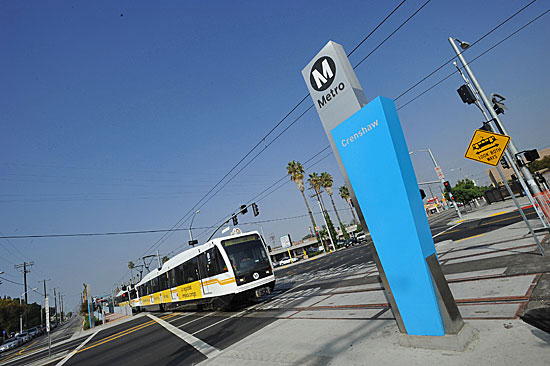
With new Westside rail service, officials want to make sure that trains, cars and pedestrians safely co-exist.
Launch time for the Expo Line means crunch time for Vijay Khawani and Barbara Burns.
With the official opening this weekend of Expo’s first phase, Metro safety and education officials like Khawani and Burns have been working their way down a to-do list that, like the line itself, stretches from downtown to La Cienega.
And then there are the new things that keep cropping up.
Like the guy in the Maserati who ignored flashing signals and almost pulled out in front of an approaching train Tuesday.
Khawani, Metro’s Executive Officer of Corporate Safety, was out on the line with inspectors from the Public Utilities Commission when he spotted the car moving toward the tracks, so he raced down the station ramp toward it, waving his arms and yelling to get the motorist’s attention.
Crisis averted.
Making sure drivers, bicyclists and pedestrians stay alert around the trains—especially while they’re still something of a novelty—is a major preoccupation as Expo gets ready to roll.
Khawani and Burns, manager of Metro’s Transit Safety Education Programs, are key players on a team that must not only ensure that Expo meets all the regulatory requirements but also presents a safe and familiar image to the public in the line’s crucial early days and weeks.
For months, Burns has been deploying a small army of “safety ambassadors”—24 retired bus and rail operators—into communities around the new line to help people navigate the new system and to report back on trouble spots.
“We start one year before any train takes the track,” she said. “In the beginning, it’s always chaotic.”
To educate the public about what’s headed their way, Burns’ team has conducted dozens of training sessions at schools, senior centers and libraries and with neighborhood watch and community groups, sent out hundreds of notices about train testing, put up 4,000 safety posters and handed out 60,000 flyers door to door.
They’ve also placed safety ads on the sides of 20 trains—with bilingual messages such as “Hear bells? See lights? Train’s coming.”
“We started to do it with the Eastside Extension (of the Gold Line) and found it to be very effective,” she said. “It’s like a moving billboard.”
Still, some people don’t get the message. There have been three collisions involving Expo Line trains since testing began—all the result of motorists proceeding against a flashing red light signaling an approaching train, Khawani said. The most recent accident, on April 19, was caused by a driver making an illegal left turn, he said.
“That type of accident is actually the most common type of light rail accident in the industry across the country,” he said. “I think education is a big component because this is something that’s new in the neighborhood. They’ve never had trains.”
Common sense goes a long way, he said. There have been no serious injuries in the Expo crashes, but a brand new Mercedes Benz was totaled on March 19 when its owner got distracted “playing around with the new navigation system,” he said.
“We can’t do it alone,” Khawani said. “They’ve got to obey the signs.”
Large crowds are expected to ride Expo for free on its inaugural weekend, Saturday and Sunday, April 28 and 29. And before the light rail makes its public bow, a series of technical and mechanical fixes have been required.
An automatic routing system to make sure Expo and Blue Line trains—which share some stations in downtown L.A.—get on their respective tracks logged 20 “misroutes” on a recent day of testing.
So at least at the beginning, controllers in Metro’s Rail Control Center (known as “The ROC”) will be routing the trains manually.
“It’s a temporary fix until we can assure ourselves that the automatic routing function is working reliably. It’s not a safety concern, it’s more an operational concern,” Khawani said. “When you’re on a train for Long Beach, you don’t want to end up in Culver City”—an unlikely scenario, he added, because the train operator would almost certainly notice the misroute before reaching the end of the line.
Another major priority is making sure that trains don’t block intersections. That has meant getting the city Department of Transportation to change signal timing to give train operators some extra “green time” to proceed through intersections—first 10 extra seconds and then, as of Sunday, 4 more.
“Four seconds make a big difference,” Khawani said. “Since Sunday, we have not seen any trains blocking any intersections. It has improved it dramatically.”
A test run Tuesday with the PUC inspectors onboard was largely successful, although two signs at the Crenshaw station needed to be relocated so trains can proceed without getting stopped between stations.
At the La Cienega station, Khawani checked to see that emergency lighting required by the L.A. Fire Department was in place and working. (It was, and he snapped a photo with his phone.)
No detail, it seems, is beneath his attention. He called in a mistake he spotted at the Western station, where a pavement sign reading “Stay Behind Yellow Line” was accidentally transposed to read “Yellow Line Stay Behind.”
Animated but apparently unflappable, Khawani has seen 20 years’ worth of launches since he joined Metro. And he says he has never doubted that the Expo Line would open Saturday.
“This is very typical of all openings,” he said. Still, don’t expect him to let his guard down anytime soon. “I don’t think there is ever a time when you get to breathe a sigh of relief.”
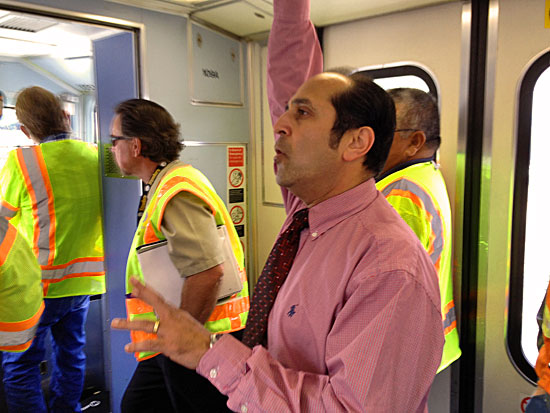
Vijay Khawani, Metro’s Executive Officer of Corporate Safety, rides Expo with safety team and PUC inspectors.
Posted 4/26/12
A free fix for low-income homeowners
April 27, 2012
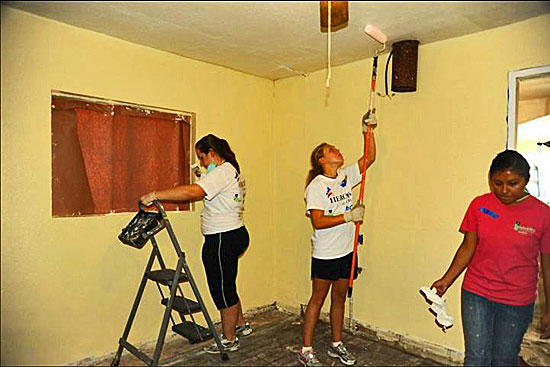
Local volunteers spruce up the home of a 97-year-old World War II vet during last year’s National Rebuilding Day.
Stuff happens. Windows break, pipes burst, circuits blow and sometimes things just slowly fall apart. When the inevitable occurs, people usually call a repair shop or climb up a ladder. But what happens when families can’t do either?
This Saturday, April 28, local volunteers will participate in National Rebuilding Day, pooling their talents to repair the homes of folks who are unable to do it themselves. The day is organized by Rebuilding Together, a nonprofit group that partners with communities to mend the homes of low-income homeowners who are seniors, disabled, veterans or families with small children.
You don’t have to be skilled to join in. Inexperienced volunteers will prepare areas for painting, bring materials to other volunteers, clean, paint and do light landscaping. Of course, experienced volunteers are welcome, too, and they will repair electrical work and install flooring, cabinets, plumbing and dry wall.
On National Rebuilding Day, Rebuilding Together of Greater Los Angeles and its affiliates across the country will improve more than 8,000 homes.
The workday starts early, at 7:30 a.m., and lasts until 3:30 p.m. Lunch will be provided. Volunteers may sign up individually or as a team, and minors under the age of 18 can join in if their parent or guardian signs an agreement and release form.
Posted 4/27/12
Films in the key of Ritts
April 27, 2012
This weekend marks the beginning of a new film series at the Getty. Titled “What Becomes a Legend,” it will screen classic films unified by their propensity to test society’s mores and boundaries.
The series is a companion to the Getty’s exhibit Herb Ritts: L.A. Style, which presents some of the renowned portrait photographer’s best fashion, celebrity and nude prints. Like Ritts, the directors of the films that will be shown had a knack for bringing out the best in their subjects, making them look like stars.
Here’s what’s showing:
Saturday, April 28
3 p.m. – The Sheik
7 p.m. – Pandora’s Box
Sunday, April 29
12 p.m. – Morocco
3 p.m. – Gilda
Saturday, May 5
3 p.m. – A Streetcar Named Desire
7 p.m. – And God Created Woman
Sunday, May 6
12 p.m. – Rebel Without a Cause
3 p.m. – Jailhouse Rock
The film series is free, but reservations are required. Visit the event page to save your seats.
Posted 4/27/12
Major work coming in Sherman Oaks
April 27, 2012
The 405 Freeway’s makeover is about to take another step forward with the widening and retrofitting of the Sepulveda Boulevard overpass in Sherman Oaks. To get the work done, the area surrounding the overpass will undergo about a year’s worth of traffic reconfiguration, beginning in early May.
For about a year, left turns from Fiume Walk and the Southbound Valley Vista off-ramp onto northbound Sepulveda will be restricted, and left turns from northbound Sepulveda onto Fiume Walk will also be restricted. Additionally, the left turn pocket onto the southbound Valley Vista on-ramp will be shortened and Sepulveda will go to two lanes in each direction near the overpass.
Meanwhile, two crosswalks will be eliminated—the crosswalk across Sepulveda at Fiume Walk and the crosswalk across Fiume which, along with sidewalk on the west side of Sepulveda, will close three months after the start of construction.
During construction, workers will perform the noisiest work during the day. Some ramps and lanes will occasionally be closed completely during off-peak hours, and Sepulveda itself will be closed during late night hours to accommodate certain building activities.
When it’s completed, the 405 project will expand capacity on one of the most heavily traveled, congested freeways in the country by adding a 10-mile northbound carpool lane, widening existing ramps and bridges, and improving the supporting infrastructure. It’s expected to be finished in 2013. Keep up with the progress on Metro’s project page and the 405 Report.
Posted 4/27/12
Searing lessons of the riots
April 26, 2012
It was several hours after the Rodney King verdicts and the city had yet to exhale. Shocked by the police acquittals, I headed to First AME Church with Mayor Tom Bradley and other civic and religious leaders to urge calm. When we stepped inside, the streets were quiet—which is why I was taken aback a short time later by the pictures of fire and violence on a TV reporter’s monitor inside the church.
“Why are you showing the ’65 Watts Riots?” I asked in a challenging tone.
“Councilman,” he said, “that’s a live shot from our helicopter.”
Within moments, I was being accompanied by a church deacon to my city car, parked near the intersection of Adams and Western. “You cannot walk there yourself,” I was told firmly. By then, every window of the vehicle had been smashed out. I was driven home by an aide to Councilman Nate Holden, who represented the area.
Today, 20 years later, images of those cataclysmic days seem as distant as the Watts Riots did to me on that evening at First AME. There’s almost a grainy, historical look to the photos and videos we’ve seen resurrected in recent days, creating a sense that this dark and transformative moment in our history is long behind us.
Yes, many of the conditions that led to the 1992 explosion of lawlessness have been repaired. One of the most significant events in the aftermath of the riots—the Christopher Commission—has led to a Police Department that is now making headlines for its partnership with minority neighborhoods, not for its hostile disrespect towards them. Today, residents in areas once deprived of the most basic commerce have access to supermarkets and businesses, though still not enough.
And imagine, two decades ago, launching a new transit system through some of the most charred stretches of the region, as we’re doing today with the Expo Line.
So when the question is asked—could it happen again?—many of us, thinking with our hearts, want to say no, of course not. But I think that would be naïve and dangerous. Although police brutality may have been the match that lit the fuse, the riots drew fuel from economic conditions that for years bred deep resentment—conditions that persist today.
We have yet to provide credible hope to those on the lower end of the income scale that they can work their way into the middle class. Employment, affordable housing, health insurance, child care, quality education, all these things and more continue to elude families living in communities enveloped by the 1965 and 1992 riots.
Too often, federal, state and local governments responsible for confronting such issues seem more interested in pointing fingers than in finding solutions. At the minimum, we elected officials must talk with the most marginalized among us and hear the challenges in their lives. The lack of such communication was one key reason the Los Angeles power structure was blindsided by the breadth of the unrest. I know this may sound ridiculously basic, but the fact is that it’s harder to ignore a person’s plight once you’ve had a conversation with them.
Today, from my vantage point on the Board of Supervisors, I can confidently state that our local governments have not shrunk from the challenges brought into harrowing relief by the flames of 20 years ago. We’ve funded neo-natal programs and created school-based health centers to make sure people, especially the youngest amongst us, receive the care they need and deserve. We’ve pushed for a “living wage” for workers at the lowest end of the earning scale. We’ve begun to clean the urban environment and create parks in communities that once offered little more than asphalt. And we’ve embarked upon an ambitious rapid transit agenda that will create thousands of jobs and bring rail transportation to neighborhoods that have gone without it for far too long.
All these share this in common: respect for human dignity. So long as we honor that notion and dedicate ourselves to reducing economic disparities, there is hope we can transform the lives of individuals and communities for the better.
Posted 4/27/12
Getting there is all the fun
April 25, 2012
When the first segment of the Expo Line opens Saturday, it will whisk transit patrons to destinations like the Coliseum and the Los Angeles County Natural History Museum. On opening day, riders won’t even need to leave the station platforms for a good time.
Celebrations with live entertainment will be held Saturday, April 28, at four stations—7th/Metro, Expo/USC, Expo/Crenshaw and La Cienega/Jefferson. There will be standard fare including live music, info booths and L.A.’s ubiquitous gourmet food trucks, but there are also a few off-the-beaten-path diversions.
For starters, how about a psychic magician with a cat assistant? The Fantastic Fig and his cat, Newton, have appeared on America’s Got Talent and the Kathy Griffin Show to perform their mind-bending card tricks. On Saturday, the crowds at La Cienega/Jefferson station will get a close look at what the Fig has up his sleeve as he performs a roving routine.
If magic’s not your bag, a professional mime will also be riding the rails, performing on trains and in stations. Artist Tony Duran of the 24th Street Theatre gives silent performances that range from purely comedic to serious and dramatic. Unfortunately, despite multiple attempts, the mime could not be reached for comment.
Alternatively, the inaugural crowds can show off their own abilities via karaoke, which takes place at Expo/Crenshaw and La Cienega/Jefferson stations. The less vocally-inclined might opt instead to memorialize the occasion in photos, using Cirque du Soleil’s “green screen” to transform themselves digitally into virtual Cirque performers, at the 7th/Metro station. In addition, photo booths will be arranged at other stations so patrons can personalize snapshots with props and possibly a map of the new light rail line as a backdrop. Photos will be posted online after the event.
In addition to the sideshows there is, of course, the main event. This weekend, the shiny new Expo Line is the belle of the ball. Free rides will be offered Saturday and Sunday, from 5 a.m. to 7 p.m. After that, the line starts taking on paying customers and will operate from 5 a.m. to midnight.
(During the inaugural run, trains will be bypassing the line’s Farmdale and Culver City stations, which are not yet completed, though they are expected to open in the weeks ahead.)
According to Anna Chen of Metro’s media relations department, the opening day fun is all about the communities Expo will serve.
“We tried to incorporate local talent and promote the businesses and vendors along the line as much as possible,” said Chen. (A look at some of the eateries and other attractions along the line is here.)
Expo is expected to be one of the nation’s most heavily-used light rail lines. A second phase to Santa Monica is now underway.
Posted 4/25/12




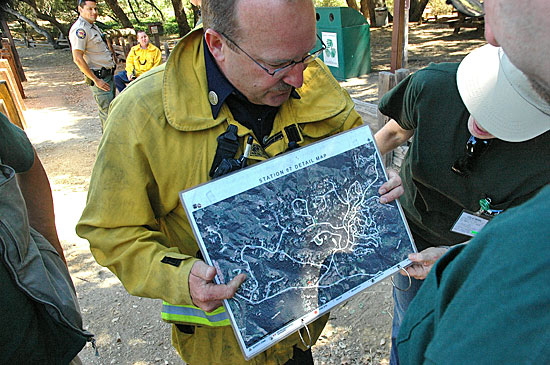
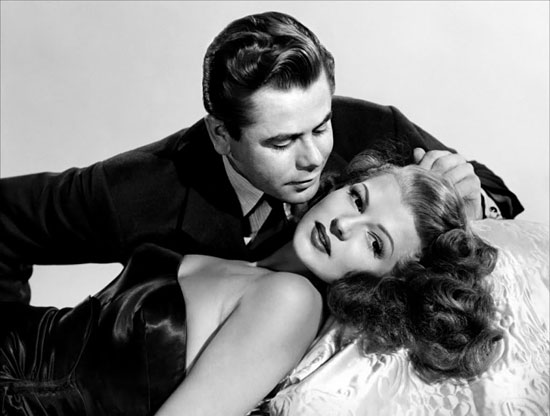
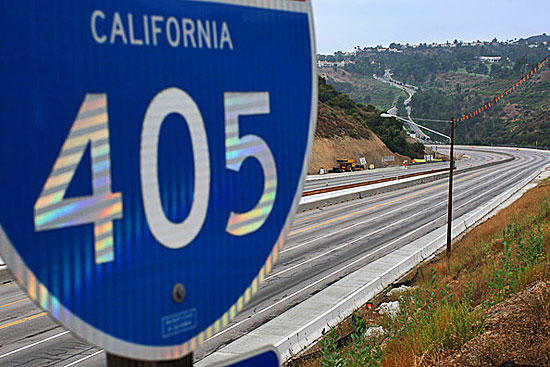
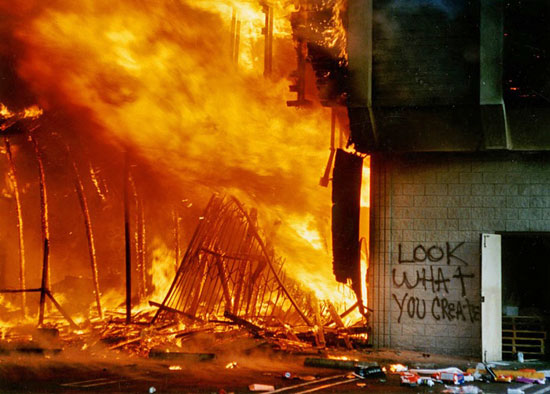
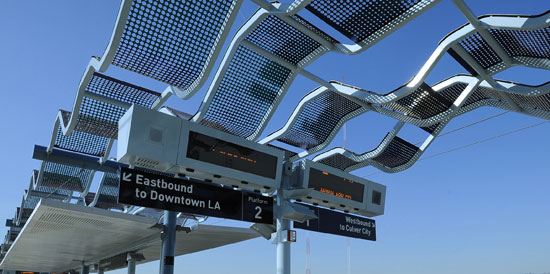





 Check for the latest closure information
Check for the latest closure information








